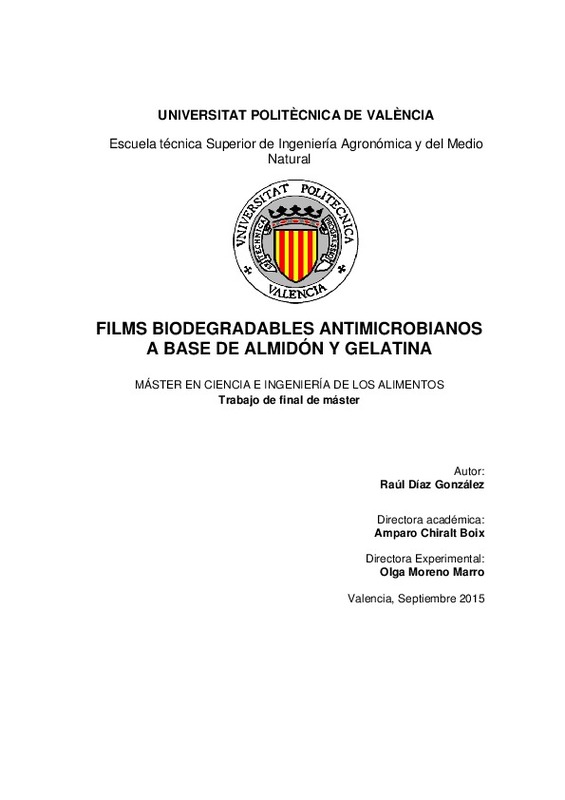|
Resumen:
|
[ES] Se elaboraron films biodegradables utilizando almidón de
maíz (CS), gelatina bovina (BG) y glicerol (GL) como plastificante, con
incorporación de agentes activos antimicrobianos lisozima (LZ) y etil lauroil
arginato ...[+]
[ES] Se elaboraron films biodegradables utilizando almidón de
maíz (CS), gelatina bovina (BG) y glicerol (GL) como plastificante, con
incorporación de agentes activos antimicrobianos lisozima (LZ) y etil lauroil
arginato (LAE), mediante extensión-secado (casting) de las dispersiones
acuosas y por termoprocesado. Se caracterizaron las propiedades físicas
(microestructurales, mecánicas, barrera, ópticas y humedad de equilibrio),
comportamiento térmico, actividad antimicrobiana de los films, así como la
actividad enzimática de la LZ. La falta de miscibilidad entre CS y BG dio
lugar a separación de fases, con formación de dominios ricos en cada uno
de los polímeros. En los films por casting se dio una estructura estratificada
debida a la diferencia de densidad de los polímeros mientras que por
termoformado se observó una distribución aleatoria de los dominios. La
adición tanto de LAE como LZ favoreció la adhesión interfacial entre
dominios de los diferentes polímeros. Este comportamiento afectó al resto de
propiedades consideradas. Los films termoprocesados fueron más
maleables y extensibles, y menos rígidos, con una menor capacidad barrera.
Además, presentaron pardeamiento, comparados con los obtenidos por
casting. Se observó actividad antimicrobiana contra Listeria innocua sólo en
el caso de las formulaciones con LAE, mostrando un efecto bactericida total.
[-]
[EN] Biodegradable films were prepared using corn starch (CS),
bovine gelatin (BG), glycerol (GL) as a plasticizer, with the incorporation of
lisozyme (LZ) and ethyl lauroyl arginate (LAE) as antimicrobial agents, ...[+]
[EN] Biodegradable films were prepared using corn starch (CS),
bovine gelatin (BG), glycerol (GL) as a plasticizer, with the incorporation of
lisozyme (LZ) and ethyl lauroyl arginate (LAE) as antimicrobial agents, by
extension-drying (casting) of the aqueous dispersions and termoprocess. The
physical properties (microstructure, mechanical, barrier, optical, and
equilibrium moisture), thermal behaviour, antimicrobial activity of the films
and the enzymatic activity of LZ were characterized. The lack of miscibility
between CS and BG resulted in phase separation with formation of rich
domains of each polymer. For the films obtained by casting, the different
density of the polymers led to a layered structure, while thermoprocessed
films showed a random distribution of the domains. The addition of LAE and
LZ favored the interfacial adhesion between the domains of different
polymers. This behavior affected the rest of the properties considered.
Thermoprocessed films were softer and more extensible, less rigid, and
showed poorer barrier capacity. They also presented browning, compared
with those obtained by casting. Antimicrobial activity against Listeria innocua
was observed only in the case of formulations containing LAE, which showed
a total bactericidal effect.
[-]
[CA] Es van elaborar films biodegradables utilitzant midó de dacsa
(CS), gelatina bovina (BG) i glicerol (GL) com a plastificant, amb la
incorporació d’agents actius antimicrobians lisozima (LZ) i etil lauroil arginat
(LAE), ...[+]
[CA] Es van elaborar films biodegradables utilitzant midó de dacsa
(CS), gelatina bovina (BG) i glicerol (GL) com a plastificant, amb la
incorporació d’agents actius antimicrobians lisozima (LZ) i etil lauroil arginat
(LAE), mitjançant extensió - secat (casting) de les dispersions aquoses i per
termoprocessat. Es van caracteritzar les propietats físiques
(microestructurals, mecàniques, barrera, òptiques i humitat d’equilibri),
comportament tèrmic, activitat antimicrobiana dels films, així com l’activitat
enzimàtica de la LZ. La falta de miscibilitat entre CS i BG va donar lloc a una
separació de fases amb formació de dominis rics en cadascun dels polímers.
Als films per casting es va donar una estructura estratificada debut a la
diferència de densitat dels polímers, mentre que als termoformats es va
observar una distribució aleatòria dels dominis. L’adició de LAE i LZ va
afavorir l’adhesió interfacial entre dominis dels diferents polímers. Aquest
comportament va afectar a la resta de propietats considerades. Els films
termoprocessats van ser més maleables i extensibles, i menys rígids, amb
una menor capacitat barrera. A més, van presentar pardejament, en
comparació amb aquells obtinguts per casting. Es va observar activitat
antimicrobiana contra Listeria innocua solament a les formulacions amb LAE,
mostrant un efecte bactericida total.
[-]
|







